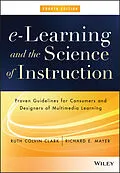The essential e-learning design manual, updated with the latest research, design principles, and examples
e-Learning and the Science of Instruction is the ultimate handbook for evidence-based e-learning design. Since the first edition of this book, e-learning has grown to account for at least 40% of all training delivery media. However, digital courses often fail to reach their potential for learning effectiveness and efficiency. This guide provides research-based guidelines on how best to present content with text, graphics, and audio as well as the conditions under which those guidelines are most effective. This updated fourth edition describes the guidelines, psychology, and applications for ways to improve learning through personalization techniques, coherence, animations, and a new chapter on evidence-based game design. The chapter on the Cognitive Theory of Multimedia Learning introduces three forms of cognitive load which are revisited throughout each chapter as the psychological basis for chapter principles. A new chapter on engagement in learning lays the groundwork for in-depth reviews of how to leverage worked examples, practice, online collaboration, and learner control to optimize learning. The updated instructor's materials include a syllabus, assignments, storyboard projects, and test items that you can adapt to your own course schedule and students.
Co-authored by the most productive instructional research scientist in the world, Dr. Richard E. Mayer, this book distills copious e-learning research into a practical manual for improving learning through optimal design and delivery.
* Get up to date on the latest e-learning research
* Adopt best practices for communicating information effectively
* Use evidence-based techniques to engage your learners
* Replace popular instructional ideas, such as learning styles with evidence-based guidelines
* Apply evidence-based design techniques to optimize learning games
e-Learning continues to grow as an alternative or adjunct to the classroom, and correspondingly, has become a focus among researchers in learning-related fields. New findings from research laboratories can inform the design and development of e-learning. However, much of this research published in technical journals is inaccessible to those who actually design e-learning material. By collecting the latest evidence into a single volume and translating the theoretical into the practical, e-Learning and the Science of Instruction has become an essential resource for consumers and designers of multimedia learning.
Autorentext
RUTH COLVIN CLARK has focused on evidence-based practice in design and development of workforce training materials for over three decades. Her recent books include Scenario-Based e-Learning and Evidence-Based Training, Second Edition.
RICHARD E. MAYER is a professor of psychology at the University of California Santa Barbara. He is an internationally recognized researcher in multimedia learning and has authored hundreds of research reports. He is the author of many books including Multimedia Learning, Computer Games for Learning, and editor of the Cambridge Handbook of Multimedia Learning, Second Edition.
Inhalt
Acknowledgments xvii
Introduction 1
1. e-Learning: Promise and Pitfalls 7
Chapter Summary 7
What Is e-Learning? 8
Is e-Learning Better? 11
Th e Promises of e?]Learning 14
Th e Pitfalls of e?]Learning 18
Inform and Perform e?]Learning Goals 19
e?-Learning Architectures 20
What Is Effective e-Courseware? 22
Learning in e-Learning 24
2. How Do People Learn from e-Courses? 29
Chapter Summary 29
How Do People Learn? 31
Managing Limited Cognitive Resources During Learning 36
How e-Lessons Affect Human Learning 39
What We Don't Know About Learning 44
3 Evidence?-Based Practice 49
Chapter Summary 49
What Is Evidence-Based Practice? 50
Three Approaches to Research on Instructional Effectiveness 51
What to Look for in Experimental Comparisons 55
How to Interpret Research Statistics 57
How Can You Identify Relevant Research? 59
Boundary Conditions in Experimental Comparisons 60
Practical Versus Theoretical Research 61
What We Don't Know About Evidence-Based Practice 62
4 Applying the Multimedia Principle: Use Words and Graphics Rather Than Words Alone 67
Chapter Summary 67
Do Visuals Make a Difference? 69
Multimedia Principle: Include Both Words and Graphics 70
Some Ways to Use Graphics to Promote Learning 74
Psychological Reasons for the Multimedia Principle 76
Evidence for Using Words and Pictures 77
The Multimedia Principle Works Best for Novices 80
Should You Change Static Illustrations into Animations? 81
What We Don't Know About Visuals 84
5 Applying the Contiguity Principle: Align Words to Corresponding Graphics 89
Chapter Summary 89
Principle 1: Place Printed Words Near Corresponding Graphics 91
Violations of Contiguity Principle 1 94
Psychological Reasons for Contiguity Principle 1 99
Evidence for Contiguity Principle 1 100
Principle 2: Synchronize Spoken Words with Corresponding Graphics 104
Violations of Contiguity Principle 2 105
Psychological Reasons for Contiguity Principle 2 107
Evidence for Contiguity Principle 2 107
What We Don't Know About Contiguity 108
6 Applying the Modality Principle: Present Words as Audio Narration Rather Than On-Screen Text 113
Chapter Summary 113
Modality Principle: Present Words as Speech Rather Than On-Screen Text 115
Limitations to the Modality Principle 117
Psychological Reasons for the Modality Principle 119
Evidence for Using Spoken Rather Than Printed Text 121
When the Modality Principle Applies 126
What We Don't Know About Modality 127
7 Applying the Redundancy Principle: Explain Visuals with Words in Audio or Text But Not Both 131
Chapter Summary 131
Principle 1: Do Not Add On?-Screen Text to Narrated Graphics 133
Psychological Reasons for the Redundancy Principle 135
Evidence for Omitting Redundant On?]Screen Text 137
Principle 2: Consider Adding On?-Screen Text to Narration in Special Situations 139
Psychological Reasons for Exceptions to the Redundancy Principle 140
Evidence for Including Redundant On-Screen Text 142
What We Don't Know About Redundancy 144
8 Applying the Coherence Principle: Adding Extra Material Can Hurt Learning 151
Chapter Summary 151
Principle 1: Avoid e?-Lessons with Extraneous Words 153
Psychological Reasons to Avoid Extraneous Words in e-Learning 155
Evidence for Omitting Extraneous Words Added for Interest 156
Evidence for Omitting Extraneous Words Added to Expand on Key Ideas 158
Evidence for Omitting Extraneous Words Added for Technical Depth 159
Principle 2: Avoid e?]Lessons with Extraneous Graphics 159
&l...